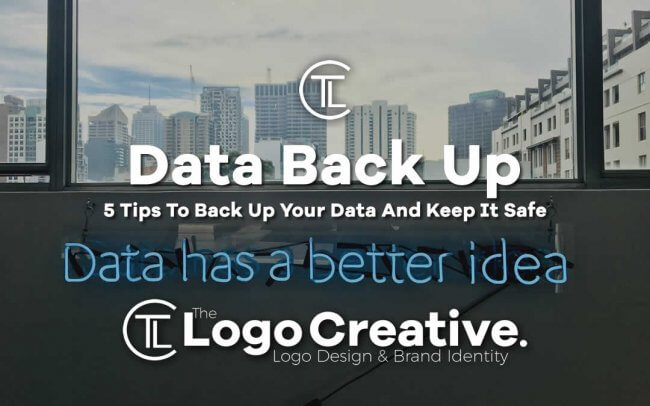Being a designer is certainly a challenge in this day and age, mainly because you have to juggle so many different things at once. Even your work has to take seat sometimes because you have to deal with demanding clients, request payment from those for which you have already delivered work, keep up with all the latest design trends and technologies, as well as struggle occasionally with burnout and lack of inspiration. However, there is one thing most of us don’t worry about it until it happens. Of course, we are talking about data backup. In this article, we discuss 5 Tips To Back Up Your Data And Keep It Safe.
Losing several weeks worth of work for an important client is every designer’s worst nightmare. And it doesn’t seem like we are learning from our mistakes either, because data loss has grown by 400% since 2012. And it’s not just the failing equipment that can hurt you either, because cybercriminals might also target your company or your client’s data. To prevent that from happening, let’s take a look at five tips you can use to back up your data and keep it safe and protected.
Table of Contents
Store Your Files in the Cloud
According to research, as many as 140,000 hard drives fail every year in the US alone, which means you should always have another internal or external hard drive which you will use for data backup. But, storage can get pretty expensive, and if you happen to need the files that you have backed up, you will have to have the disk on you, which means you should carry it just in case. Most working professionals hate that idea, which is why cloud storage services have become so popular. And it’s pretty easy to see why.
Not only do they offer some free storage space, as well as affordable fees if you need to store more files, but some of them also come with end-to-end encryption. And as if that wasn’t enough, you can always access your files no matter where you are and which device you are using, which is something that any designer, engineer, or cybersecurity specialist can appreciate. You don’t have to worry about your hard drive malfunctioning ever again.
Get an External Hard Drive
Now, as great as cloud storage is, it does have a few downsides. First of all, unless you have money to burn, you are probably going to have to limit the amount of data you want to back up. Second, you never know when a service which offers cloud storage might close down. Third, you need a high-speed internet connection to access your files. With an external hard drive, you can access your files offline and even use them along with software which allows for automatic period backup of your most precious designs.
As for reliability, it’s pretty hard to expect that both your primary and backup hard drive will fail at the same time, but in order to minimize the consequences when that happens, you can do a few things. According to Thomas Williams, who is a manager for Best Essays, you can opt for solid-state drives which, while much more expensive, are much more reliable than their HDD counterparts, since they feature no moving parts. On top of that, they are much faster and lighter.
Diversify Your Storage Locations
You can interpret diversification in two different ways. First is storing your most important designs and files using both the cloud and your external hard drive, which should provide an additional layer of security and redundancy. Second, you should try and store your data in different places. Why should you do this? Well, let’s imagine there is a fire in your office building or a burst pipe. Even if you have all of your files backed up neatly and safely, fire or water would get to both your computer and your external drive, since they are pretty much next to each other, and your backup would be rendered pointless, despite your best efforts.
So, the best course of action would be to keep your external storage on an off-site location. If you really want to have quick access to some of your more important data, you can back it up using USB drives, which are extremely portable, reliable, and relatively cheap. In an ideal case, you should have all of your files saved in the cloud and on an external drive, but that is an option that requires a larger budget.
Standardize Your Filing System
Now, a lot of designers thrive on what some may call “creative chaos”, which somehow tends to spill over into the way they store and organize their files and data. This usually isn’t an issue until you need to access your backup data and then you find yourself not knowing where to find what you are looking for because everything is lumped into one big folder. Then, you have to spend a ton of time organizing everything. This is why you should always come up with a naming and filing system which you will stick to no matter the device or storage option.
Another benefit of having a filing system, aside from speed and order, is the fact that you will be able to see your newest backups, which should help you with orientation and organization even further.
Choose Which Files Your Back Up
While it may be great to back up every single file you have, at least in theory, there are several reasons why you should do otherwise. First of all, there is the cost of everything. The more files you back up, the more you will have to pay for cloud and/or external storage. Second, as the quantity of data you want to back up grows, you will be less likely to do it on a regular basis, and then you’ll end up not backing anything up at all. Third, you probably have a ton of files on your hard drive that are in no way related to your work, and which don’t need to be saved.
Go through your files and folders and determine which ones are essential and which you couldn’t do without and then back them up on a regular basis, as opposed to throwing everything but the kitchen sink at your external storage solution of choice.
Final Word
As a designer, you need to make sure that none of your hard work and designs will ever go to waste. By not backing up your files, you not only risk losing time but also your clients. We hope that these five tips will help you prevent that from happening. Good luck!
 Author Bio
Author Bio
Michael Gorman is a UK-based freelance blogger and writer at bestessayservicereviews. Aside from indulging in his love for the written word, he also likes to spend time in nature and playing his guitar, when not pondering all the different aspects of human existence.

